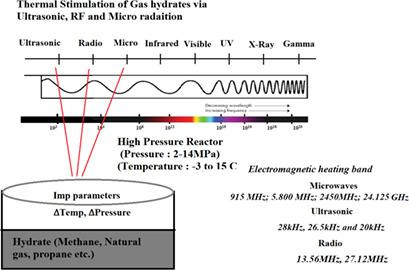当前位置:
X-MOL 学术
›
ChemBioEng Rev.
›
论文详情
Our official English website, www.x-mol.net, welcomes your feedback! (Note: you will need to create a separate account there.)
Hydrate Dissociation Using Microwaves, Radio Frequency, Ultrasonic Radiation, and Plasma Techniques
ChemBioEng Reviews ( IF 4.8 ) Pub Date : 2020-07-23 , DOI: 10.1002/cben.202000004 Shadman H. Khan 1 , Ashwani K. Misra 2 , Chandrajit B. Majumder 1 , Amit Arora 3
ChemBioEng Reviews ( IF 4.8 ) Pub Date : 2020-07-23 , DOI: 10.1002/cben.202000004 Shadman H. Khan 1 , Ashwani K. Misra 2 , Chandrajit B. Majumder 1 , Amit Arora 3
Affiliation

|
In this work, a comprehensive review of technologies employing radiation sources such as microwave, ultrasonic, and radio frequency (RF) on gas hydrates is presented. The characterizing parameters of radiation, such as frequency, wavelength, and power are highlighted for the compiled studies. In addition, characterizing parameters like hydrate dissociation rate, irradiated microwave power, complete dissociation time, reaction paths and mechanisms, differential pressure and temperature of gas hydrates during the experiments are also reported. Moreover, the work also describes the basic concept behind the working of the different wave forms such as microwaves, ultrasonic, RF wave and plasma for hydrate dissociation.
中文翻译:

使用微波,射频,超声辐射和等离子技术进行水合物分解
在这项工作中,将对使用辐射源(例如微波,超声波和射频(RF))对气体水合物的技术进行全面的综述。对于已编译的研究,突出显示了辐射的特征参数,例如频率,波长和功率。此外,还报告了表征水合物离解速率,辐射微波功率,完全离解时间,反应路径和机理,气体水合物压差和温度的表征参数。此外,该工作还描述了用于微波分解,微波,超声波,RF波和等离子分解水合物的各种波形背后的基本概念。
更新日期:2020-07-23
中文翻译:

使用微波,射频,超声辐射和等离子技术进行水合物分解
在这项工作中,将对使用辐射源(例如微波,超声波和射频(RF))对气体水合物的技术进行全面的综述。对于已编译的研究,突出显示了辐射的特征参数,例如频率,波长和功率。此外,还报告了表征水合物离解速率,辐射微波功率,完全离解时间,反应路径和机理,气体水合物压差和温度的表征参数。此外,该工作还描述了用于微波分解,微波,超声波,RF波和等离子分解水合物的各种波形背后的基本概念。



























 京公网安备 11010802027423号
京公网安备 11010802027423号